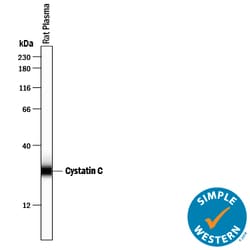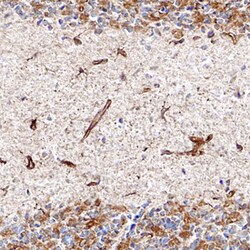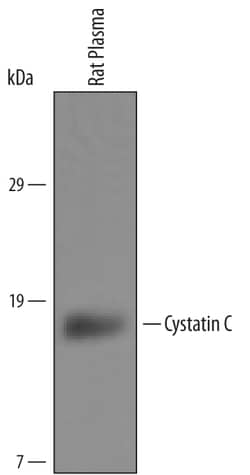Promotional price valid on web orders only. Your contract pricing may differ. Interested in signing up for a dedicated account number?
Learn More
Learn More
Rat Cystatin C Antibody, R&D Systems™


Sheep Polyclonal Antibody
Supplier: R&D Systems AF6154SP
This item is not returnable.
View return policy
Description
Cystatin C Polyclonal specifically detects Cystatin C in Rat samples. It is validated for Western Blot, Simple Western, Immunohistochemistry, Immunoprecipitation.Specifications
| Cystatin C | |
| Polyclonal | |
| Unconjugated | |
| Lyophilized from a 0.2 μm filtered solution in PBS with Trehalose. *Small pack size (SP) is supplied as a 0.2 μm filtered solution in PBS. with No Preservative | |
| ARMD11, bA218C14.4 (cystatin C), CST3, cystatin 3, cystatin C, cystatin C (amyloid angiopathy and cerebral hemorrhage), cystatin-3, cystatin-C, Gamma-trace, MGC117328, Neuroendocrine basic polypeptide, Post-gamma-globulin | |
| Sheep | |
| Antigen Affinity-purified | |
| RUO | |
| 1471 | |
| Reconstitute at 0.2 mg/mL in sterile PBS. | |
| Use a manual defrost freezer and avoid repeated freeze-thaw cycles. 12 months from date of receipt, -20 to -70 degreesC as supplied. 1 month, 2 to 8 degreesC under sterile conditions after reconstitution. 6 months, -20 to -70 degreesC under sterile conditions after reconstitution. |
| Western Blot, Immunohistochemistry, Immunoprecipitation | |
| LYOPH | |
| Western Blot 1 ug/mL, Simple Western 10 ug/mL, Immunohistochemistry 5-15 ug/mL, Immunoprecipitation 25 ug/mL | |
| P14841 | |
| CST3 | |
| Mouse myeloma cell line NS0-derived recombinant rat Cystatin C Met1-Ala140 Accession # P14841 | |
| 25 μg | |
| Primary | |
| Detects rat Cystatin C in direct ELISAs and Western blots. In direct ELISAs, approximately 30% cross-reactivity with recombinant mouse Cystatin C and approximately 15% cross-reactivity with recombinant human Cystatin C is observed. | |
| Rat | |
| IgG |
Product Content Correction
Your input is important to us. Please complete this form to provide feedback related to the content on this product.
Product Title
For Research Use Only
Spot an opportunity for improvement?Share a Content Correction


